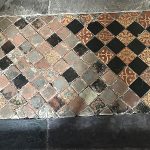 National Trust. The present version of the castle was built in the early 17th century in a ‘medieval revival’ style, but has undergone some revisions since, including the demolition of the servants’ wing. The Croft family were forced to sell in 1746 but their trustees repurchased the castle in 1923.
National Trust. The present version of the castle was built in the early 17th century in a ‘medieval revival’ style, but has undergone some revisions since, including the demolition of the servants’ wing. The Croft family were forced to sell in 1746 but their trustees repurchased the castle in 1923.
In the late 1580s, the original castle was converted into an Elizabethan house, which was severely damaged during the Civil War. The house was remodelled in a Gothic style in the 1760s by its then owner Thomas Johnes. A lesser remodelling took place in 1913, with changes made to the entrance front and the crenellations. In 1937, a 17th century service wing to the north-west was demolished. In 1957, after fears about demolition, funds were raised for an endowment and the house was donated to the National Trust.
The principal rooms have some fine interiors with furniture and paintings.
The adjacent church is older than the house. The walled garden and glasshouse are also worth a visit. On the wider estate you can find the Fishpool Valley and an ancient hill fort.























Skip to content
Author Kim J Cowie's travel blog
